MIS for Nike: Analysis of Logistics and Supply Chain Management Issues
VerifiedAdded on 2023/04/24
|8
|1563
|102
Report
AI Summary
This report provides a comprehensive analysis of Nike's Management Information Systems (MIS) within its logistics and supply chain management. It begins with a problem analysis, identifying key issues such as problems with inventory tracking software, issues with i2 software, lack of strategic IT planning, integration issues, and inefficiencies in decision-making systems. The report then delves into potential solutions, recommending systems like SAP BusinessObjects, Riskturn, and TIBCO Spotfire to enhance decision-making and business performance. Furthermore, it explores the implementation of solutions such as NetSuite and Logiwa WMS to address the identified challenges. The report also discusses different project life cycles, concluding with a recommendation for Logiwa WMS as a suitable technological solution to resolve Nike's i2 software implementation issues. The report emphasizes the importance of effective MIS in streamlining operations, improving decision-making, and ultimately, enhancing Nike's overall business performance.
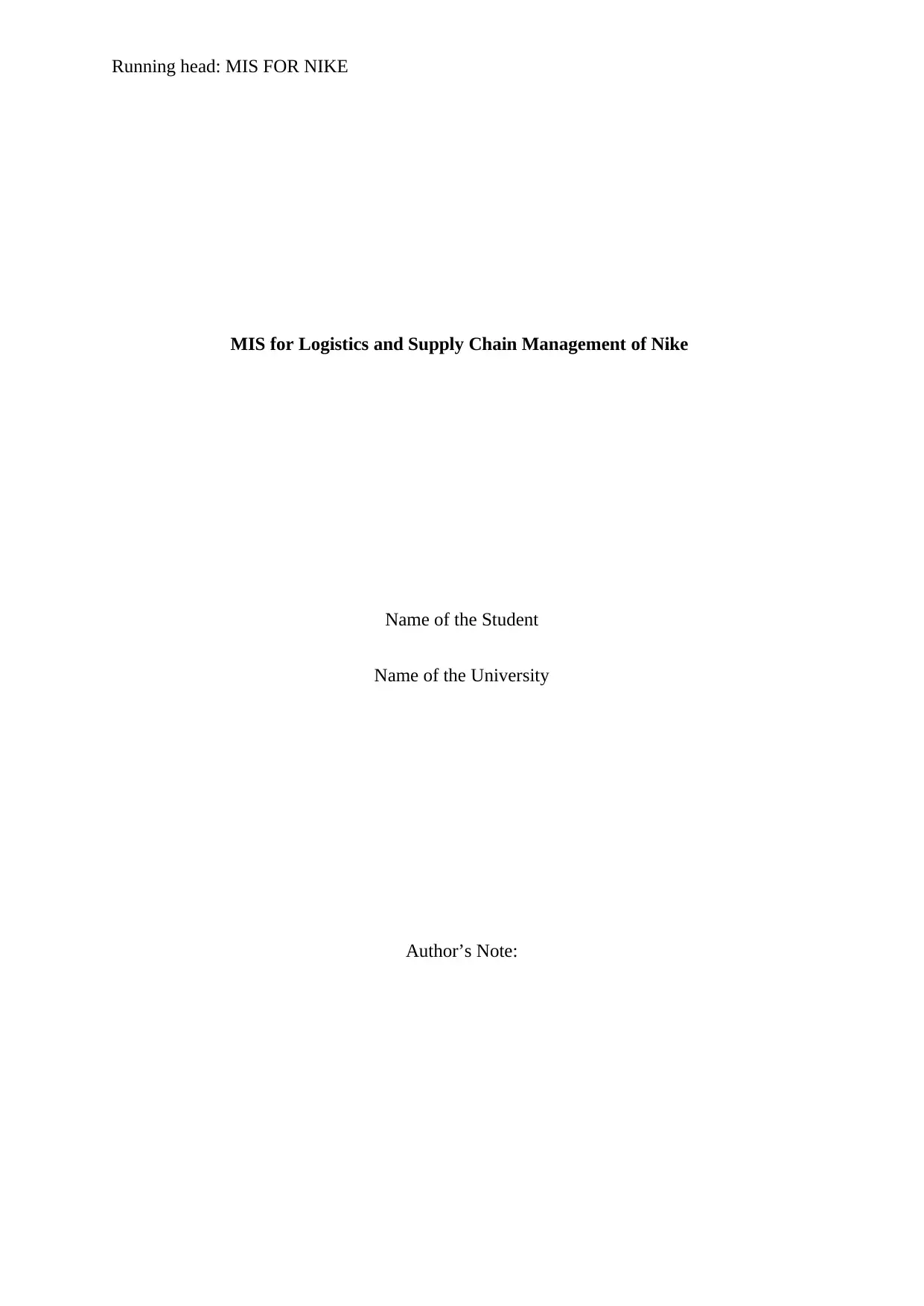
Running head: MIS FOR NIKE
MIS for Logistics and Supply Chain Management of Nike
Name of the Student
Name of the University
Author’s Note:
MIS for Logistics and Supply Chain Management of Nike
Name of the Student
Name of the University
Author’s Note:
Paraphrase This Document
Need a fresh take? Get an instant paraphrase of this document with our AI Paraphraser
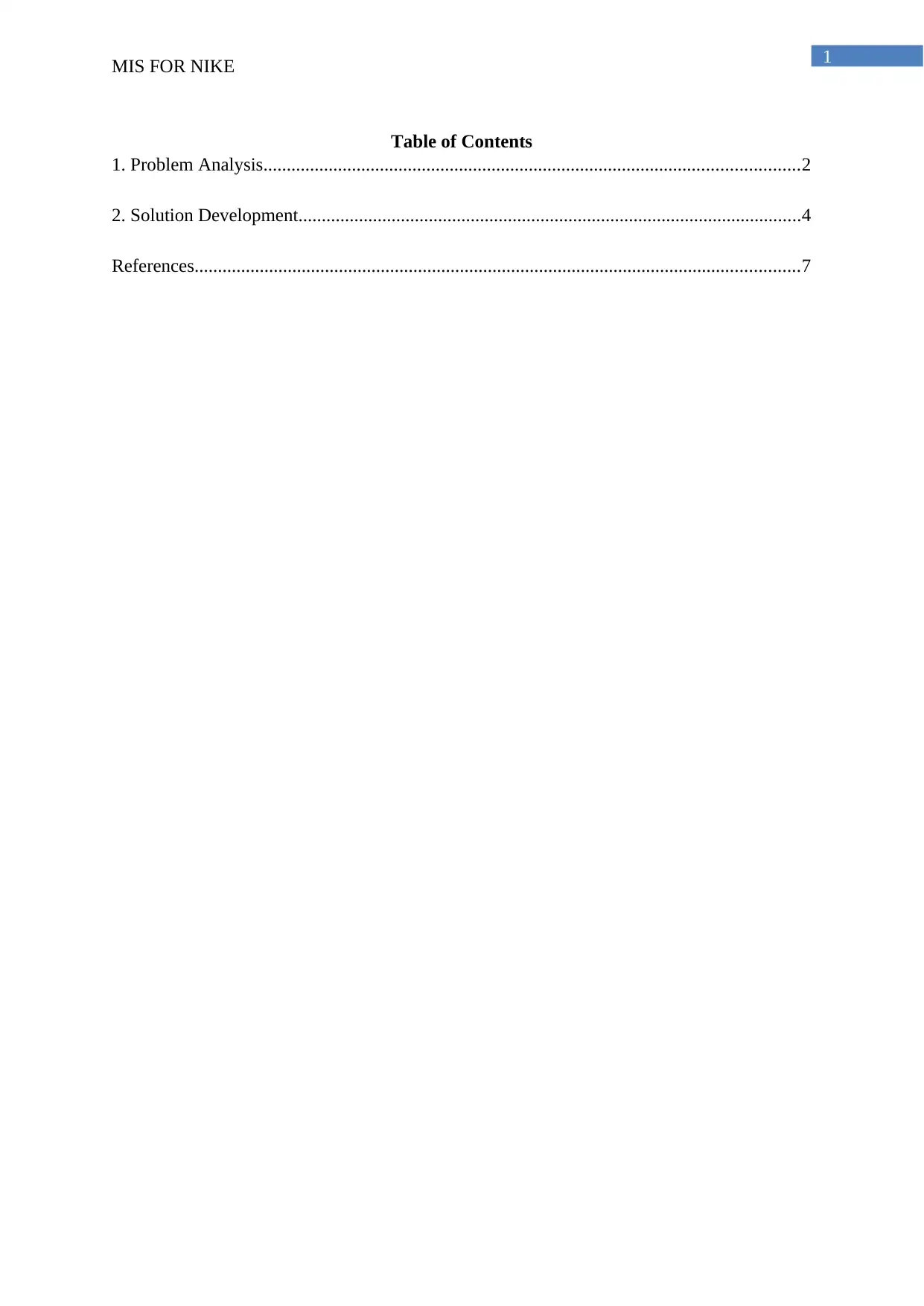
1
MIS FOR NIKE
Table of Contents
1. Problem Analysis...................................................................................................................2
2. Solution Development............................................................................................................4
References..................................................................................................................................7
MIS FOR NIKE
Table of Contents
1. Problem Analysis...................................................................................................................2
2. Solution Development............................................................................................................4
References..................................................................................................................................7
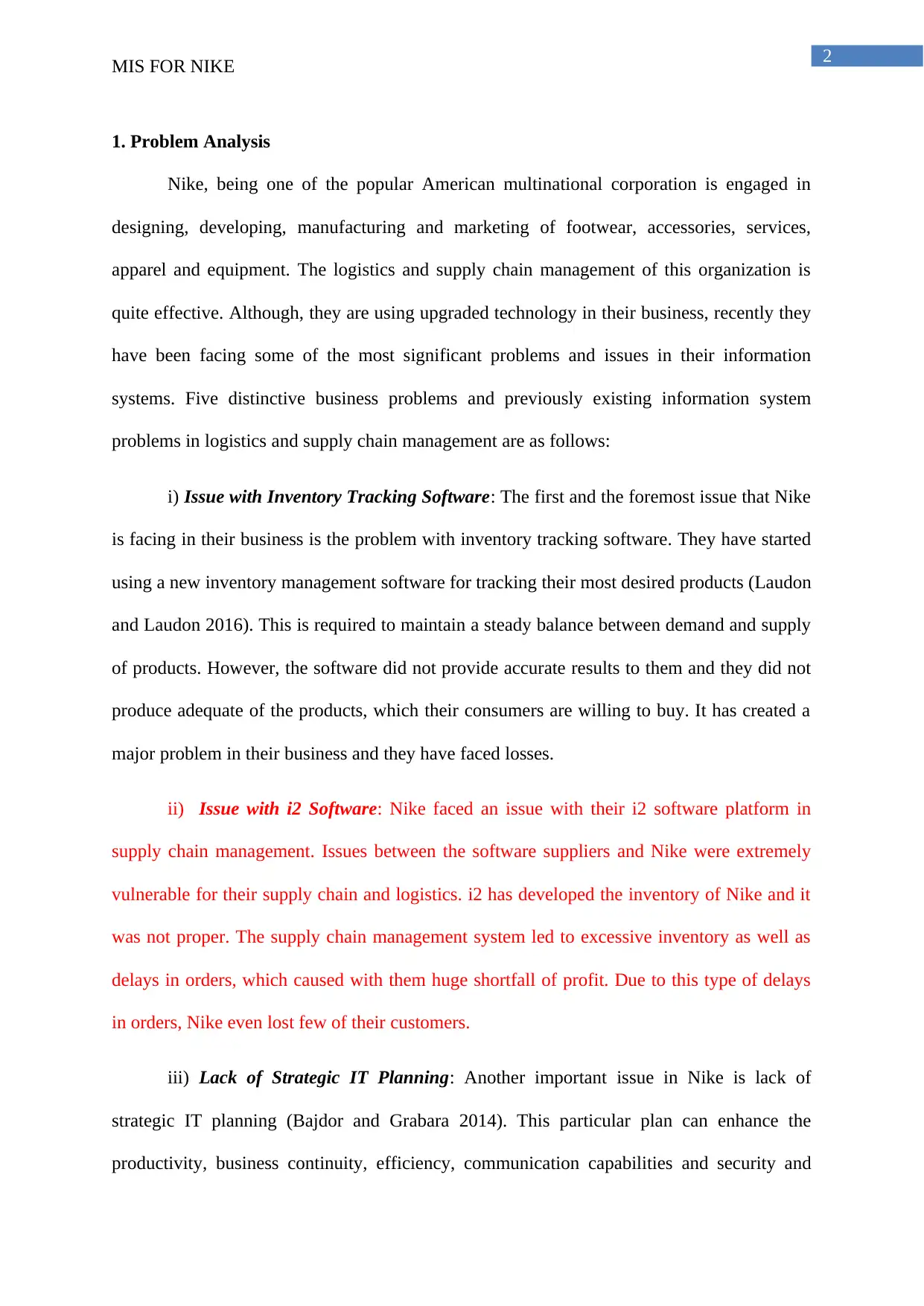
2
MIS FOR NIKE
1. Problem Analysis
Nike, being one of the popular American multinational corporation is engaged in
designing, developing, manufacturing and marketing of footwear, accessories, services,
apparel and equipment. The logistics and supply chain management of this organization is
quite effective. Although, they are using upgraded technology in their business, recently they
have been facing some of the most significant problems and issues in their information
systems. Five distinctive business problems and previously existing information system
problems in logistics and supply chain management are as follows:
i) Issue with Inventory Tracking Software: The first and the foremost issue that Nike
is facing in their business is the problem with inventory tracking software. They have started
using a new inventory management software for tracking their most desired products (Laudon
and Laudon 2016). This is required to maintain a steady balance between demand and supply
of products. However, the software did not provide accurate results to them and they did not
produce adequate of the products, which their consumers are willing to buy. It has created a
major problem in their business and they have faced losses.
ii) Issue with i2 Software: Nike faced an issue with their i2 software platform in
supply chain management. Issues between the software suppliers and Nike were extremely
vulnerable for their supply chain and logistics. i2 has developed the inventory of Nike and it
was not proper. The supply chain management system led to excessive inventory as well as
delays in orders, which caused with them huge shortfall of profit. Due to this type of delays
in orders, Nike even lost few of their customers.
iii) Lack of Strategic IT Planning: Another important issue in Nike is lack of
strategic IT planning (Bajdor and Grabara 2014). This particular plan can enhance the
productivity, business continuity, efficiency, communication capabilities and security and
MIS FOR NIKE
1. Problem Analysis
Nike, being one of the popular American multinational corporation is engaged in
designing, developing, manufacturing and marketing of footwear, accessories, services,
apparel and equipment. The logistics and supply chain management of this organization is
quite effective. Although, they are using upgraded technology in their business, recently they
have been facing some of the most significant problems and issues in their information
systems. Five distinctive business problems and previously existing information system
problems in logistics and supply chain management are as follows:
i) Issue with Inventory Tracking Software: The first and the foremost issue that Nike
is facing in their business is the problem with inventory tracking software. They have started
using a new inventory management software for tracking their most desired products (Laudon
and Laudon 2016). This is required to maintain a steady balance between demand and supply
of products. However, the software did not provide accurate results to them and they did not
produce adequate of the products, which their consumers are willing to buy. It has created a
major problem in their business and they have faced losses.
ii) Issue with i2 Software: Nike faced an issue with their i2 software platform in
supply chain management. Issues between the software suppliers and Nike were extremely
vulnerable for their supply chain and logistics. i2 has developed the inventory of Nike and it
was not proper. The supply chain management system led to excessive inventory as well as
delays in orders, which caused with them huge shortfall of profit. Due to this type of delays
in orders, Nike even lost few of their customers.
iii) Lack of Strategic IT Planning: Another important issue in Nike is lack of
strategic IT planning (Bajdor and Grabara 2014). This particular plan can enhance the
productivity, business continuity, efficiency, communication capabilities and security and
⊘ This is a preview!⊘
Do you want full access?
Subscribe today to unlock all pages.

Trusted by 1+ million students worldwide
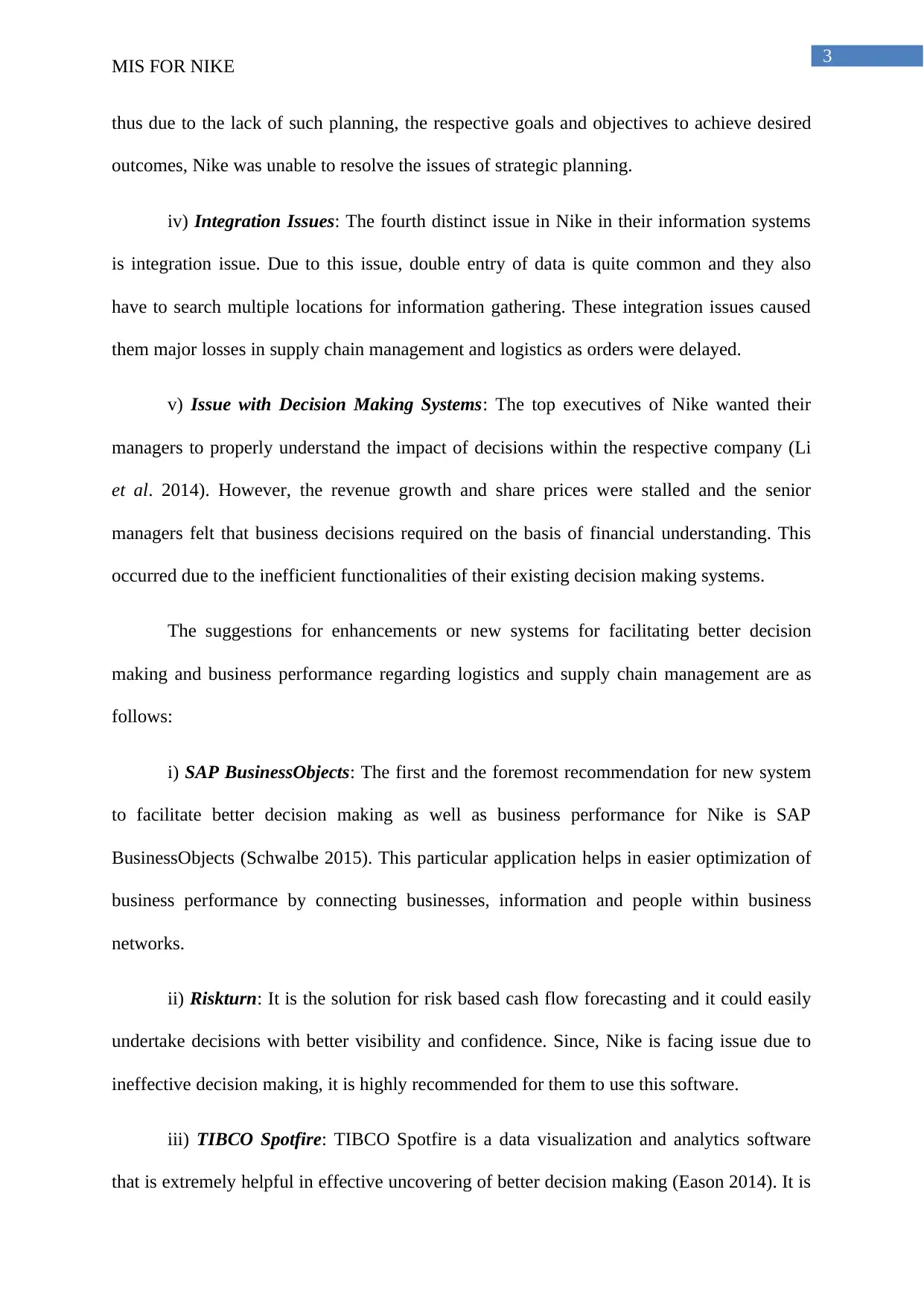
3
MIS FOR NIKE
thus due to the lack of such planning, the respective goals and objectives to achieve desired
outcomes, Nike was unable to resolve the issues of strategic planning.
iv) Integration Issues: The fourth distinct issue in Nike in their information systems
is integration issue. Due to this issue, double entry of data is quite common and they also
have to search multiple locations for information gathering. These integration issues caused
them major losses in supply chain management and logistics as orders were delayed.
v) Issue with Decision Making Systems: The top executives of Nike wanted their
managers to properly understand the impact of decisions within the respective company (Li
et al. 2014). However, the revenue growth and share prices were stalled and the senior
managers felt that business decisions required on the basis of financial understanding. This
occurred due to the inefficient functionalities of their existing decision making systems.
The suggestions for enhancements or new systems for facilitating better decision
making and business performance regarding logistics and supply chain management are as
follows:
i) SAP BusinessObjects: The first and the foremost recommendation for new system
to facilitate better decision making as well as business performance for Nike is SAP
BusinessObjects (Schwalbe 2015). This particular application helps in easier optimization of
business performance by connecting businesses, information and people within business
networks.
ii) Riskturn: It is the solution for risk based cash flow forecasting and it could easily
undertake decisions with better visibility and confidence. Since, Nike is facing issue due to
ineffective decision making, it is highly recommended for them to use this software.
iii) TIBCO Spotfire: TIBCO Spotfire is a data visualization and analytics software
that is extremely helpful in effective uncovering of better decision making (Eason 2014). It is
MIS FOR NIKE
thus due to the lack of such planning, the respective goals and objectives to achieve desired
outcomes, Nike was unable to resolve the issues of strategic planning.
iv) Integration Issues: The fourth distinct issue in Nike in their information systems
is integration issue. Due to this issue, double entry of data is quite common and they also
have to search multiple locations for information gathering. These integration issues caused
them major losses in supply chain management and logistics as orders were delayed.
v) Issue with Decision Making Systems: The top executives of Nike wanted their
managers to properly understand the impact of decisions within the respective company (Li
et al. 2014). However, the revenue growth and share prices were stalled and the senior
managers felt that business decisions required on the basis of financial understanding. This
occurred due to the inefficient functionalities of their existing decision making systems.
The suggestions for enhancements or new systems for facilitating better decision
making and business performance regarding logistics and supply chain management are as
follows:
i) SAP BusinessObjects: The first and the foremost recommendation for new system
to facilitate better decision making as well as business performance for Nike is SAP
BusinessObjects (Schwalbe 2015). This particular application helps in easier optimization of
business performance by connecting businesses, information and people within business
networks.
ii) Riskturn: It is the solution for risk based cash flow forecasting and it could easily
undertake decisions with better visibility and confidence. Since, Nike is facing issue due to
ineffective decision making, it is highly recommended for them to use this software.
iii) TIBCO Spotfire: TIBCO Spotfire is a data visualization and analytics software
that is extremely helpful in effective uncovering of better decision making (Eason 2014). It is
Paraphrase This Document
Need a fresh take? Get an instant paraphrase of this document with our AI Paraphraser
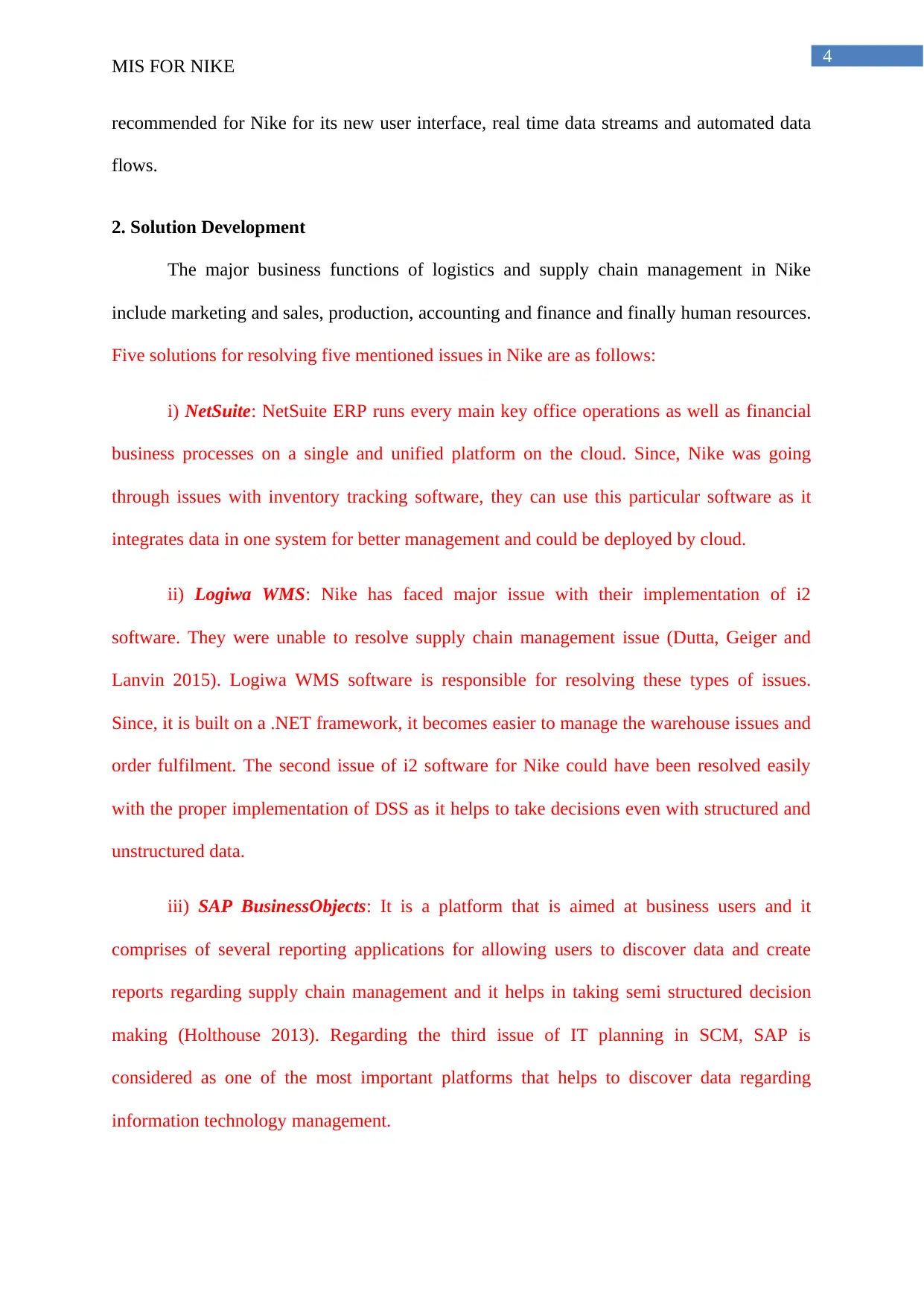
4
MIS FOR NIKE
recommended for Nike for its new user interface, real time data streams and automated data
flows.
2. Solution Development
The major business functions of logistics and supply chain management in Nike
include marketing and sales, production, accounting and finance and finally human resources.
Five solutions for resolving five mentioned issues in Nike are as follows:
i) NetSuite: NetSuite ERP runs every main key office operations as well as financial
business processes on a single and unified platform on the cloud. Since, Nike was going
through issues with inventory tracking software, they can use this particular software as it
integrates data in one system for better management and could be deployed by cloud.
ii) Logiwa WMS: Nike has faced major issue with their implementation of i2
software. They were unable to resolve supply chain management issue (Dutta, Geiger and
Lanvin 2015). Logiwa WMS software is responsible for resolving these types of issues.
Since, it is built on a .NET framework, it becomes easier to manage the warehouse issues and
order fulfilment. The second issue of i2 software for Nike could have been resolved easily
with the proper implementation of DSS as it helps to take decisions even with structured and
unstructured data.
iii) SAP BusinessObjects: It is a platform that is aimed at business users and it
comprises of several reporting applications for allowing users to discover data and create
reports regarding supply chain management and it helps in taking semi structured decision
making (Holthouse 2013). Regarding the third issue of IT planning in SCM, SAP is
considered as one of the most important platforms that helps to discover data regarding
information technology management.
MIS FOR NIKE
recommended for Nike for its new user interface, real time data streams and automated data
flows.
2. Solution Development
The major business functions of logistics and supply chain management in Nike
include marketing and sales, production, accounting and finance and finally human resources.
Five solutions for resolving five mentioned issues in Nike are as follows:
i) NetSuite: NetSuite ERP runs every main key office operations as well as financial
business processes on a single and unified platform on the cloud. Since, Nike was going
through issues with inventory tracking software, they can use this particular software as it
integrates data in one system for better management and could be deployed by cloud.
ii) Logiwa WMS: Nike has faced major issue with their implementation of i2
software. They were unable to resolve supply chain management issue (Dutta, Geiger and
Lanvin 2015). Logiwa WMS software is responsible for resolving these types of issues.
Since, it is built on a .NET framework, it becomes easier to manage the warehouse issues and
order fulfilment. The second issue of i2 software for Nike could have been resolved easily
with the proper implementation of DSS as it helps to take decisions even with structured and
unstructured data.
iii) SAP BusinessObjects: It is a platform that is aimed at business users and it
comprises of several reporting applications for allowing users to discover data and create
reports regarding supply chain management and it helps in taking semi structured decision
making (Holthouse 2013). Regarding the third issue of IT planning in SCM, SAP is
considered as one of the most important platforms that helps to discover data regarding
information technology management.
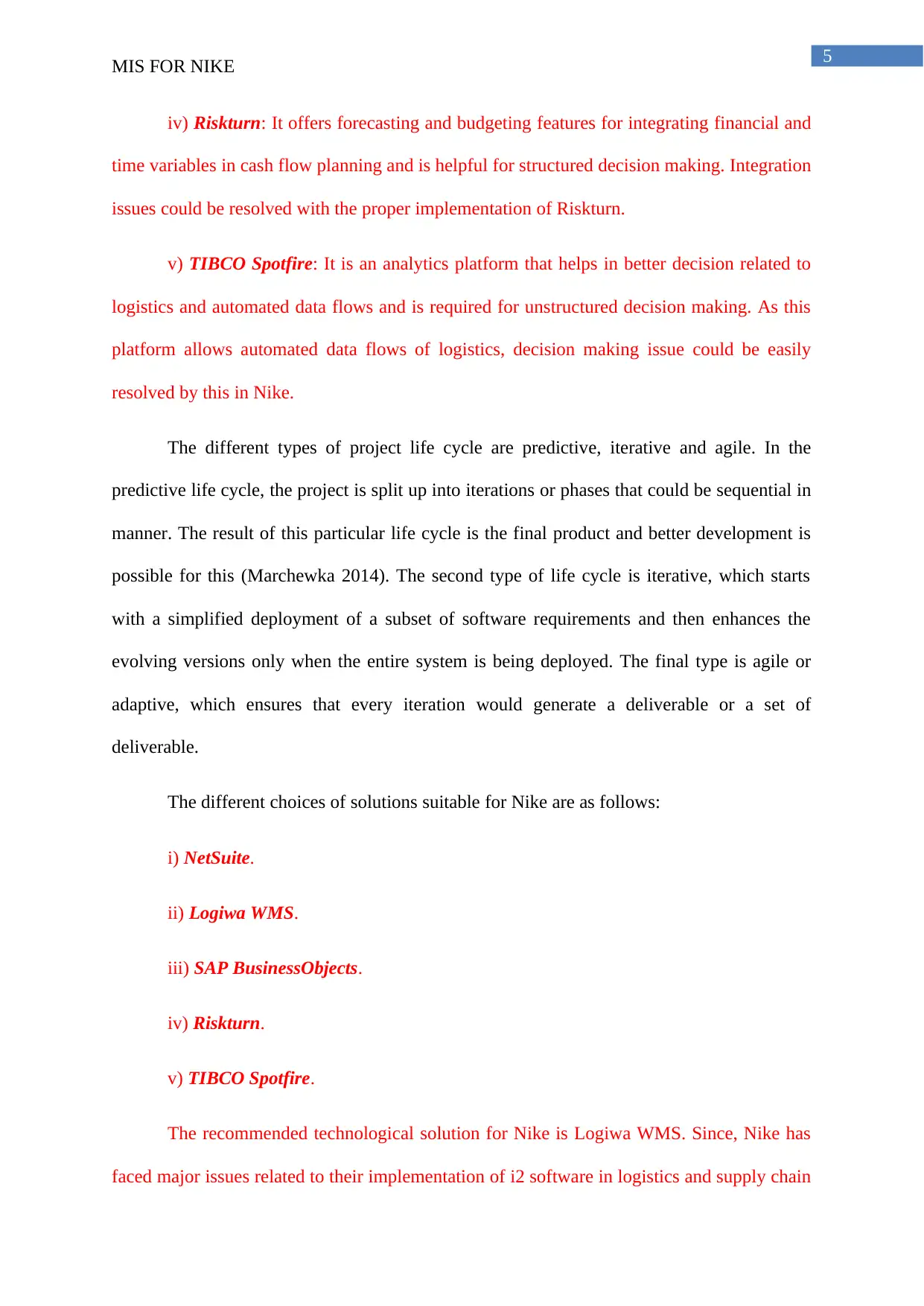
5
MIS FOR NIKE
iv) Riskturn: It offers forecasting and budgeting features for integrating financial and
time variables in cash flow planning and is helpful for structured decision making. Integration
issues could be resolved with the proper implementation of Riskturn.
v) TIBCO Spotfire: It is an analytics platform that helps in better decision related to
logistics and automated data flows and is required for unstructured decision making. As this
platform allows automated data flows of logistics, decision making issue could be easily
resolved by this in Nike.
The different types of project life cycle are predictive, iterative and agile. In the
predictive life cycle, the project is split up into iterations or phases that could be sequential in
manner. The result of this particular life cycle is the final product and better development is
possible for this (Marchewka 2014). The second type of life cycle is iterative, which starts
with a simplified deployment of a subset of software requirements and then enhances the
evolving versions only when the entire system is being deployed. The final type is agile or
adaptive, which ensures that every iteration would generate a deliverable or a set of
deliverable.
The different choices of solutions suitable for Nike are as follows:
i) NetSuite.
ii) Logiwa WMS.
iii) SAP BusinessObjects.
iv) Riskturn.
v) TIBCO Spotfire.
The recommended technological solution for Nike is Logiwa WMS. Since, Nike has
faced major issues related to their implementation of i2 software in logistics and supply chain
MIS FOR NIKE
iv) Riskturn: It offers forecasting and budgeting features for integrating financial and
time variables in cash flow planning and is helpful for structured decision making. Integration
issues could be resolved with the proper implementation of Riskturn.
v) TIBCO Spotfire: It is an analytics platform that helps in better decision related to
logistics and automated data flows and is required for unstructured decision making. As this
platform allows automated data flows of logistics, decision making issue could be easily
resolved by this in Nike.
The different types of project life cycle are predictive, iterative and agile. In the
predictive life cycle, the project is split up into iterations or phases that could be sequential in
manner. The result of this particular life cycle is the final product and better development is
possible for this (Marchewka 2014). The second type of life cycle is iterative, which starts
with a simplified deployment of a subset of software requirements and then enhances the
evolving versions only when the entire system is being deployed. The final type is agile or
adaptive, which ensures that every iteration would generate a deliverable or a set of
deliverable.
The different choices of solutions suitable for Nike are as follows:
i) NetSuite.
ii) Logiwa WMS.
iii) SAP BusinessObjects.
iv) Riskturn.
v) TIBCO Spotfire.
The recommended technological solution for Nike is Logiwa WMS. Since, Nike has
faced major issues related to their implementation of i2 software in logistics and supply chain
⊘ This is a preview!⊘
Do you want full access?
Subscribe today to unlock all pages.

Trusted by 1+ million students worldwide

6
MIS FOR NIKE
management. Hence, they should implement Logiwa WMS software in their business. This
solution will support disparate warehousing processes, there will be different product groups
and the requirements of various sectors in a single platform will be fulfilled.
MIS FOR NIKE
management. Hence, they should implement Logiwa WMS software in their business. This
solution will support disparate warehousing processes, there will be different product groups
and the requirements of various sectors in a single platform will be fulfilled.
Paraphrase This Document
Need a fresh take? Get an instant paraphrase of this document with our AI Paraphraser
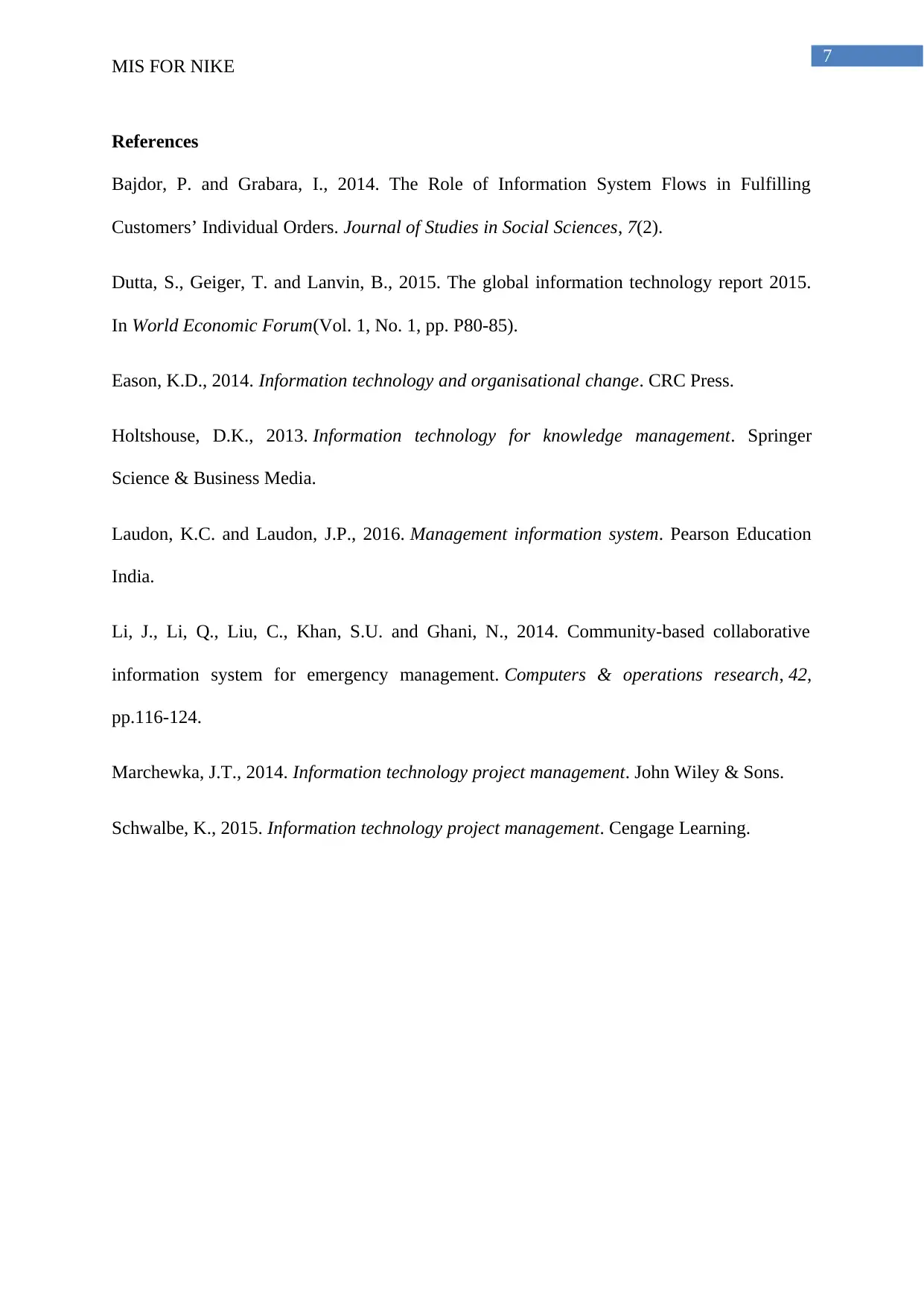
7
MIS FOR NIKE
References
Bajdor, P. and Grabara, I., 2014. The Role of Information System Flows in Fulfilling
Customers’ Individual Orders. Journal of Studies in Social Sciences, 7(2).
Dutta, S., Geiger, T. and Lanvin, B., 2015. The global information technology report 2015.
In World Economic Forum(Vol. 1, No. 1, pp. P80-85).
Eason, K.D., 2014. Information technology and organisational change. CRC Press.
Holtshouse, D.K., 2013. Information technology for knowledge management. Springer
Science & Business Media.
Laudon, K.C. and Laudon, J.P., 2016. Management information system. Pearson Education
India.
Li, J., Li, Q., Liu, C., Khan, S.U. and Ghani, N., 2014. Community-based collaborative
information system for emergency management. Computers & operations research, 42,
pp.116-124.
Marchewka, J.T., 2014. Information technology project management. John Wiley & Sons.
Schwalbe, K., 2015. Information technology project management. Cengage Learning.
MIS FOR NIKE
References
Bajdor, P. and Grabara, I., 2014. The Role of Information System Flows in Fulfilling
Customers’ Individual Orders. Journal of Studies in Social Sciences, 7(2).
Dutta, S., Geiger, T. and Lanvin, B., 2015. The global information technology report 2015.
In World Economic Forum(Vol. 1, No. 1, pp. P80-85).
Eason, K.D., 2014. Information technology and organisational change. CRC Press.
Holtshouse, D.K., 2013. Information technology for knowledge management. Springer
Science & Business Media.
Laudon, K.C. and Laudon, J.P., 2016. Management information system. Pearson Education
India.
Li, J., Li, Q., Liu, C., Khan, S.U. and Ghani, N., 2014. Community-based collaborative
information system for emergency management. Computers & operations research, 42,
pp.116-124.
Marchewka, J.T., 2014. Information technology project management. John Wiley & Sons.
Schwalbe, K., 2015. Information technology project management. Cengage Learning.
1 out of 8
Related Documents
Your All-in-One AI-Powered Toolkit for Academic Success.
+13062052269
info@desklib.com
Available 24*7 on WhatsApp / Email
![[object Object]](/_next/static/media/star-bottom.7253800d.svg)
Unlock your academic potential
Copyright © 2020–2025 A2Z Services. All Rights Reserved. Developed and managed by ZUCOL.





